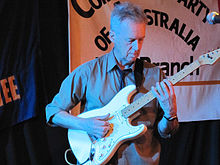- Mike Rudd
-
Mike Rudd Background information Also known as My Crudd Born 15 June 1945 Origin  Christchurch, New Zealand
Christchurch, New ZealandGenres Progressive Rock, Blues Occupations Musician, Songwriter, Producer Instruments Vocals, Guitar, Harmonica, Recorder, Bass, Keyboard Years active 1960s–present Labels Havoc, EMI, Mushroom, Rare Vision, Volcano Associated acts Chants R&B, The Party Machine, Sons of the Vegetal Mother, Spectrum, Indelible Murtceps, Ariel, Mike Rudd & The Heaters, WHY Website http://www.mikeruddbillputt.com Notable instruments L Series Fender Stratocaster Mike Rudd is a New Zealand born musician and composer who has been based in Australia since the late 1960s, and who is best known as the leader of respected Australian progressive rock bands Spectrum and Ariel in the 1970s.
Rudd's first major group in New Zealand was the Chants R&B. The group came to Australia and settled in Melbourne in 1966 but broke up soon afterwards. Rudd then joined The Party Machine led by Ross Wilson and Ross Hannaford, who are best known in Australia for the group they formed subsequently, Daddy Cool.
After Party Machine split up in late 1969, Rudd formed his own band, Spectrum, one of Australia's first progressive rock groups. This also marked the beginning of his long association with bassist Bill Putt. Spectrum released four LPs and several 7" singles, including their national #1 hit single "I'll Be Gone", which has remained one of the best-known songs of the period, and the first Australian rock double album, Milesago. The group also worked under the pseudonym Indelible Murtceps and recorded one LP under that name.
After Spectrum split in April 1973, Rudd and Putt formed a new group, Ariel. Along with keyboard player John Mills they joined forces with two leading Sydney musicians, guitarist Tim Gaze and drummer Nigel Macara from pioneering progressive band Tamam Shud. They released one successful LP, A Strange Fantastic Dream, in December 1973, but Gaze and Macara left the band soon after it was recorded.
In early 1974 Rudd and Putt began work on an extended concept piece, The Jellabad Mutant, and began rehearsing the music with drummer John Lee, ex-The Dingoes. Lee then brought in a friend, lead guitarist Harvey James, and this arrangement eventually coalesced into the second lineup of Ariel. They recorded a full-length demo tape of the planned LP, called The Jellabad Mutant, and presented it to their record label EMI, but to their surprise it was rejected.
However, by this time the band had gained some critical praise in the United Kingdom, thanks in part to leading disc jockey John Peel, and this led EMI's parent office in London to invite the group to record their next album at the world-famous Abbey Road Studios. However the rejection of the Mutant album left the band with no new material, and when they arrived in London they discovered that EMI were expecting the lineup that had recorded the first LP. Rudd hastily wrote a number of new songs, but to complete the LP they were forced to fall back on Rudd's back-catalogue, recording new versions of several Spectrum/Murtceps songs. The resulting album, Rock'n'Roll Scars, was mixed by famous EMI recording engineer Geoff Emerick, who had worked with The Beatles.
In January 1975 Ariel was expanded to a five-piece with the addition of respected New Zealand singer-songwriter-guitarist Glyn Mason. This lineup recorded only one single and lasted until early 1976. Lead guitarist Harvey James left to join chart-topping Australian pop band Sherbet in March (he was replaced by keyboardist Tony Slavich) and drummer John Lee quit to join English band Dirty Tricks during Ariel's second visit to the UK in April. He was briefly replaced by Nigel Macara, who quit again in October 1976 to be replaced by Iain McLennan.
Ariel continued to record and perform until July 1977, when they announced their break-up; they performed their farewell concert at the Dallas Brooks Hall in Melbourne on 31 August 1977; the show was recorded and later released on two LP's: Aloha; then Ariel Live!!-More From Before.
After Ariel, Mike Rudd moved into promotion and production for a time. He produced the debut album for Newcastle bands Daniel and Jab and demos for Jane Conway (ex-Melbourne band Stiletto).
Rudd and Putt later formed a succession of groups, in the 1980s—Mike Rudd's Instant Replay, Mike Rudd & The Heaters (both also with Tony Slavich) and the more electronically oriented W.H.Y. -- but none achieved the same level of success as Spectrum or Ariel.
Although Rudd was forced to withdraw from performing for several years due to the illness and subsequent death of his wife Helen, Mike and Bill have sustained an enduring musical partnership, including reunions of Spectrum during the '80s, and a duo album in 1996, Living On A Volcano. A new 3-piece incarnation of Spectrum, with drummer Peter Robertson, debuted in the late 1990s with a CD Spectrum Plays The Blues, which took them back to their musical roots. Ariel also reformed for occasional gigs with varying lineups, including a final reunion of the 'Mark II' lineup with Harvey James and John Lee, which took place not long before Lee's untimely death in July 1998.
Rudd, Putt and Robertson continue to perform and record as Spectrum, with occasional help from keyboardist Daryl Roberts.
External links
- http://www.mikeruddbillputt.com
- http://www.milesago.com/Artists/ArtistFrames.htm Milesago website, contains link to Spectrum biography page.
- Spectrum - Mike Rudd and Bill Putt's story and music
Categories:- 1945 births
- Living people
- Australian musicians
Wikimedia Foundation. 2010.

